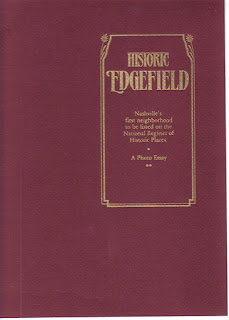Edgefield
In the shadow of Nashville's skyscrapers looming beyond the Cumberland River lies a fifteen-square-block residential area with the intriguing name of Edgefield. This inner-city historical district began as a suburban home site for John Shelby in 1818, who over time built two imposing homes there, "Fatherland" and "Boscobel." Both have long since vanished, but something of the earliest history of Edgefield remains with streets bearing those names. During the nearly two centuries since its beginnings, the area was subdivided and prospered, was struck by tragedy and rebuilt, only to eventually fall into a decline it might never have recovered from. Then a community group promoted the inclusion of Edgefield in the National Register of Historic Places in 1977, the first neighborhood so designated in Nashville. Since then, Historic Edgefield, Inc. has achieved a small miracle of matching the aesthetic values of historical integrity to contemporary housing needs along with community responsibility.A visitor to the area might be struck by the varied appearance of the architecture that denotes its history. An expert eye could locate the sparely elegant homes of the early classical period; the eclectic Victorian styles, including Italianate, Gothic, Romanesque, Queen Anne, and Eastlake; the four-square and solid turn-of-the-century homes and public buildings; the Craftsman bungalow styles of the early 20th century; and in muted echoes of the earlier periods, brand-new cityhomes and townhouses. Yet architecture is only part of the story of Edgefield, for familiar names of past residents should find its way into a history of the area, especially the notorious "Mr. Howard, Grain Speculator," alias Jesse James, who for a time lived on Fatherland Street. (He and his wife, Zee, took up residence there in 1875 as a hideout until 1881 when the place got too hot for them, and they decamped back to Missouri. During those Nashville years, the Jameses lived on his ill gotten gains as he continued his nefarious activities in outlying areas.)
When John Shelby, in 1854, decided to turn his estate into housing tracts, Edgefield was ripe for growth, and influential citizens of Nashville scrambled to build in what was to become the most fashionable location around. In 1868 the community was incorporated as an independent municipality. Soon its burgeoning residential population demanded the construction of schools, churches, and commercial enterprises. Eventually seeing an urgent need for more public services to the little city, in 1880 Edgefield officially became part of Nashville.
The bell of St. Ann's Episcopal Church frantically tolling a warning knell, calamity struck Edgefield when the great fire of 1916 cut a swath through the area. The devastation was enormous, the fire leveling over six hundred homes and other structures. With so many of the older homes gone, the look of the neighborhood began to change as new post-World War I houses filled in some of the vacant lots. (A 1933 tornado as well as another devastating one in 1998 wreaked further havoc on structures and the landscape.) Until World War II, Edgefield continued as a viable community, but the years of the late 1940s and ‘50s saw movement away from the old neighborhood into new, distant suburbs. Traffic-laden roads and highways were by-passing the once proud area, turning it into a nearly forgotten way-station. Edgefield was not forgotten, however.
Today, the streets of Edgefield are quiet but wonderfully alive. Neighbors may be found greeting one another along the broad, brick sidewalks that invite a stroll. An Eastlake cottage may be getting its wood siding retouched in one of the vibrant, earthy hues authentic to that period. A Queen Anne two-story may be having its garden replanted. While Edgefield is no longer on the edge of the city, it appears now to be on the edge of an exciting future, delicately poised between the ideals of preservation and the drama of continued renewal.

Interesting historical piece, thanks for sharing.
ReplyDeleteFascinating story and great information. I appreciate you sharing this. Your research is valuable to the preservation of Nashville’s heritage. I am going to forward a link of your blog to Carol Bucy in the history department at the college. If she is not familiar with this story, she will be enjoy reading about it. Keep up the good work. I love hearing about the rich history in Tennessee. It makes me want to drive down to pay a visit.
ReplyDeletePaul
Paul, thanks for your interest. I now have a link to Historic Edgefield, Inc., which tells of the Haunted History House Tour, October 22. Check it out.
ReplyDeleteJeanne, Sorry to be so late getting around to your blog again. I really enjoyed this piece of writing. I grew up in the Inglewood area in the '40s and '50s and as you say remember Edgefield during the time when people (myself included) were passing it by almost unnoticed. Renewed today, it's a beautiful area.
ReplyDelete